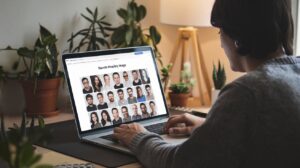Best Way to Search People By Image
Have you ever found a captivating image online and wondered who is in it? Or maybe you’ve stumbled upon a photo with no context and wished you could trace its origin. Thanks to modern technology, searching for people by image has never been easier. Reverse image search tools allow you to identify individuals, discover their social media profiles, or even find similar pictures across the web. This fascinating process opens up countless possibilities—whether you’re investigating an intriguing subject or seeking to verify someone’s identity. Let’s dive into how reverse image search works and explore its benefits!
How it Works
Reverse image search operates through advanced algorithms that analyze the visual elements of an image. When you upload a picture, these tools break it down into various features such as colors, shapes, and patterns.
After analyzing the image, the technology compares it to vast databases containing millions of images. This comparison helps identify similar or identical images across different websites.
The process is powered by machine learning techniques that constantly improve accuracy over time. The more data these systems process, the better they become at recognizing faces and objects within pictures.
Once matched results are found, users receive links where those images appear online. This enables them to find information about people or discover sources associated with specific photos quickly and efficiently.
Benefits of Using Reverse Image Search
Reverse image search offers several compelling advantages. It allows users to quickly identify the source of an image, which can be crucial for verifying authenticity.
Another benefit is its ability to uncover related content. You might discover similar photos or different resolutions that enhance your understanding of a subject. This feature is particularly useful for researchers and journalists seeking comprehensive information.
Additionally, reverse image search helps prevent copyright infringement. By tracing images back to their origins, creators can ensure they receive proper credit for their work.
For those looking to connect with others online, this tool aids in finding profiles associated with a particular picture. Whether you’re trying to reconnect with an old friend or verify someone’s identity, it streamlines the process significantly.
Moreover, it’s not just about personal use; businesses can leverage reverse image search for market analysis and competitor insights as well.
Popular Tools for Reverse Image Search
When it comes to searching for people by image, several tools stand out in the digital landscape. Google Images is one of the most popular options. Simply upload an image or paste a URL, and you can find similar images across the web.
TinEye is another powerful tool that specializes in reverse image searches. It focuses on tracking where an image appears online, making it great for verifying sources or uncovering original content.
Bing Visual Search also offers a user-friendly experience. Its interface allows users to drop images directly into the search bar. This feature simplifies finding visually similar images or related content.
Social media platforms like Facebook and Instagram have their own built-in reverse image search capabilities through features like “Find Photos” and tagging suggestions. These tools help connect faces with profiles effortlessly, enhancing your ability to discover more about individuals through visuals alone.
Steps to Perform a Reverse Image Search
Performing a reverse image search is simple and straightforward. Start by selecting the image you want to search for. This can be an existing photo on your device or one from a website.
Next, navigate to a reliable reverse image search tool. Popular options include Google Images, TinEye, and Bing Visual Search. Each platform has its own unique features that enhance your experience.
Once you’re on the chosen site, upload the image or paste its URL into the designated field. After hitting enter or clicking “search,” wait briefly for the results to populate.
Browse through the returned images and links to find relevant information about the person in question. Keep an eye out for similar photos and any associated websites that might provide further details about them.
Tips for Getting Accurate Results
To get the most accurate results when you search people by image, start with high-quality images. Blurry or pixelated pictures can lead to unreliable matches.
Consider using images that clearly show the person’s face. Close-ups work best, as they provide more detail for identification.
If possible, use a photo where the person is alone. Background distractions can confuse search algorithms and produce less relevant results.
Try different angles or expressions if your first attempt doesn’t yield good results. Sometimes a slight change in perspective can help refine the search.
Also, experimenting with various reverse image search tools may improve your chances of finding someone accurately. Each tool uses unique technology that might return distinct outcomes. 
Combine image searches with other information about the individual to enhance accuracy further. This multi-faceted approach often leads to better success in identifying people online.
How to Use Reverse Image Search in Different Situations
Reverse image search is incredibly versatile and can be applied in various scenarios.
If you’re trying to identify someone in a social media photo, upload the image directly to a reverse image search tool. This might lead you to their profile or other images they’ve shared online.
When dealing with suspicious or unknown images, this method can help verify authenticity. A simple upload could reveal if an image has been misused elsewhere on the web.
For creatives and marketers, tracing visual content back to its origin helps ensure proper attribution. This practice fosters respect for intellectual property and avoids potential copyright issues.
Travel enthusiasts can use it too; searching for pictures of landmarks often uncovers stunning travel blogs or reviews related to that place.
Whether for personal curiosity or professional needs, knowing how to leverage reverse image search opens many doors across different contexts.
Conclusion
Searching for people by image can be a game-changer in today’s digital landscape. It opens up a world of possibilities, whether you’re trying to verify someone’s identity or track down lost connections. With the right tools and techniques at your disposal, you can navigate through vast amounts of visual data with ease.
As we’ve discussed, reverse image search is not just about finding similar pictures; it’s also an effective method for gathering information about individuals based on their images. Utilizing popular tools simplifies the process significantly, allowing you to access various results quickly.
The benefits are clear: increased security, enhanced social interactions, and even opportunities for networking or business development arise from being able to trace images back to their sources. Knowing how to perform an effective reverse image search empowers you as a user in both online and offline contexts.
By adhering to some simple tips while searching—like using high-resolution images—you’ll improve your chances of obtaining accurate results. Whether it’s confirming someone’s profile picture on social media or investigating an unfamiliar face captured in a photo, these strategies will serve you well.
Mastering the art of searching people by image helps transform how we interact with our digital environment—and may lead you to discover more than just faces along the way.



